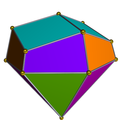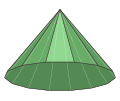Top Qs
Timeline
Chat
Perspective
Pentadecahedron
Polyhedron with 15 faces From Wikipedia, the free encyclopedia
Remove ads
A pentadecahedron (or pentakaidecahedron) is a polyhedron with 15 faces. No pentadecahedron is regular; hence, the name is ambiguous. There are numerous topologically distinct forms of a pentadecahedron, for example the tetradecagonal pyramid, and tridecagonal prism. In the pentadecahedron, none of the shapes are regular polyhedra. In other words, a regular pentadecahedron does not exist, and the pentadecahedron cannot fill space; a space-filling pentadecahedron does not exist.[1]
You can help expand this article with text translated from the corresponding article in Chinese. (June 2023) Click [show] for important translation instructions.
|
In chemistry, some clusters of atoms are in the form of pentadecahedra.[2] Calculations have shown that there is a unit cell of the pentadecahedron that is stable in the crystal.[3]
Remove ads
Convex
There are 23,833,988,129 topologically distinct convex pentadecahedra, excluding mirror images, having at least 10 vertices.[4] (Two polyhedra are "topologically distinct" if they have intrinsically different arrangements of faces and vertices, such that it is impossible to distort one into the other simply by changing the lengths of edges or the angles between edges or faces.)
Common pentadecahedra
Remove ads
References
External links
Wikiwand - on
Seamless Wikipedia browsing. On steroids.
Remove ads






